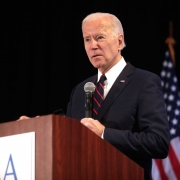Moderation’s Limits: Centrist Democrats Short-Term Triumph
Moderate Democrats are celebrating Joe Biden’s big Super Tuesday, but their joy may reflect a short-term triumph of the party’s past over its longer-term future. The sudden consolidation of the moderate vote around Biden, paced by the relative inability of Michael Bloomberg to spend his way into relevance, has elevated the creaking former vice president to the top of the pack, mainly as the most likely alternative to socialist senator Bernie Sanders. Moderation may have triumphed for now, with help from African-American and older voters, but the Sanders–Elizabeth Warren wing of the Democratic Party remains the choice of rising demographic groups of the future, namely Latinos and voters under 30.
The Democrats’ leftist future can be glimpsed in the country’s two biggest and most important states, Texas and California. These economic powerhouses are the nurseries of the new America, with Latinos constituting 30 percent of the eligible electorate in each. One state leans red, while the other is, for now at least, solid blue, but each has developed political models—one conservative, the other progressive—that now compete for America’s political future.
The electoral patterns in Texas, which Biden narrowly won, were marked by divisions of age and ethnicity. Voters over 65 went for Biden nearly four to one, according to Washington Post exit polls. By contrast, among voters under 30, Sanders cleaned up, beating Biden 59 percent to 13 percent. African-Americans, who constitute 20 percent of the state’s electorate, gave nearly three-fifths of their votes to Biden, almost four times Sanders’s share. Carroll Robinson, who served on the Houston City Council for six years and is chairman of the Coalition of Black Democrats, notes that Sanders failed to connect, particularly with older black voters; he cites in particular his being the only major candidate not to attend the 55th anniversary of “Bloody Sunday” at the Edmund Pettus Bridge in Selma as reflective of his “signaling problem” with African-American voters.
Black voters, Robinson notes, were critical to Biden’s small margin of victory, boosting his totals in Harris County, which includes Houston, and in Dallas County. In contrast, Latinos, already roughly one-third of the state’s Democratic voters, voted heavily for Sanders. The Vermont senator won roughly 40 percent of Latino voters, compared with about a quarter who opted for Biden. Sanders won easily in heavily Latino Bexar (San Antonio), Hidalgo (the Rio Grande Valley), and El Paso Counties.
Sanders also appealed to younger voters in Texas, as elsewhere, beating Biden among voters under 30—making up some 15 percent of the electorate—by almost four to one. He won hugely in Austin, the state’s epicenter of millennial culture, with its high concentration of tech workers. Sanders easily took Travis County over Biden, 83,000 to 52,000.
Moderate Texas Democrats can take heart in halting the momentum of a socialist candidate, but the broader trend is against them. According to exit polls, some 56 percent of Texas Democrats view socialism favorably. In Houston, voters elected an inexperienced 27-year-old progressive, Lina Hidalgo, as judge of Harris County in 2018. Despite its title, the role is nonjudicial; Hidalgo is actually the chief executive of the nation’s third most-populous county. This year, Christian Menefee, a young social-justice advocate, won the primary for Harris County Attorney over more mainstream opposition, on a platform of progressive criminal-justice reform. “There’s an incipient change among the grassroots activists,” notes Bill White, former Houston mayor and deputy energy secretary under Bill Clinton. “There’s a whole new group who are very anti-establishment and gaining influence.” White suspects that the ascendency of these forces may just be beginning. Sanders and Warren—before she dropped out of the race on Thursday—enjoyed a combined 40 percent support of the Texas Democratic electorate, running strongest among the fastest-growing demographic groups.
This leftward transformation is even further along in California. As Morley Winograd, a longtime Democratic activist and former aide to Al Gore, suggests, the state is not only “unique politically, but also big enough to have its own weather system. Democrats in the state feel the economy is strong enough to allow it to maintain its current high-tax, high regulation environment without causing a major downturn.” Socialism remains in vogue. At last year’s state party convention, when former Colorado governor John Hickenlooper, then a presidential aspirant, suggested that “socialism is not the answer,” he was lustily booed…
Read the rest of the piece at City Journal.
Joel Kotkin is the Presidential Fellow in Urban Futures at Chapman University and Executive Director for the Center for Opportunity Urbanism. His last book was The Human City: Urbanism for the Rest of Us (Agate, 2017). His next book, The Coming of Neo-Feudalism: A Warning to the Global Middle Class, is now available to preorder. You can follow him on Twitter @joelkotkin
Photo credit: Gage Skidmore via Flickr under CC 2.0 License.

 Gage Skidmore; used under CC 2.0 License.
Gage Skidmore; used under CC 2.0 License.
